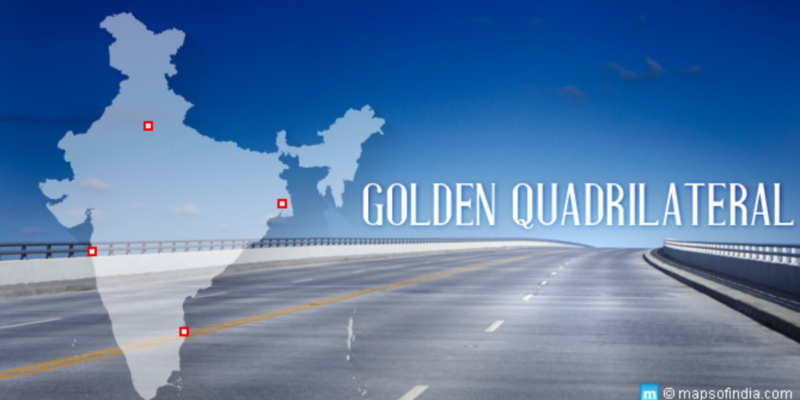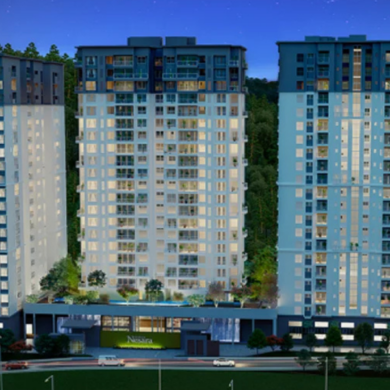
Golden Quadrilateral Project (GQ) revolutionises India’s infrastructure by connecting metros, boosting trade, accelerating real estate growth, and integrating smart industrial cities through future-ready, multimodal connectivity.
Imagine driving on smooth expressways, reaching destinations faster, and watching once-remote areas transform into thriving commercial zones. Whether you are planning long-distance travel, expanding your business reach, or exploring real estate opportunities near major corridors, the Golden Quadrilateral highway network offers unmatched convenience and connectivity across the country.
Golden Quadrilateral project – also known as Svarnim Chaturbhuj – is India’s largest and the world’s fifth longest highway project. Benefits of GQ include reduced travel time, improved logistics, and rising land value along strategic routes. In this blog, you can discover how India’s most ambitious road development initiative continues to impact your lifestyle, investments, and the country’s infrastructure story.
Table of Contents
What is the Golden Quadrilateral Project India?
One of the most transformative infrastructure projects since independence, Golden Quadrilateral India was conceptualised to link major metro cities through a network of high-speed roads. It connects Delhi, Mumbai, Chennai and Kolkata in a massive quadrilateral shape, forming a continuous loop of national highways that enables smoother intercity travel and trade.
Created under the National Highways Development Project, Golden Quadrilateral highways enhance road connectivity, reduce travel time, and support economic development by modernising India’s old road systems. You experience faster transport, lower fuel expenses, and greater convenience while commuting between states or transporting goods.
With better connectivity comes direct access to emerging job markets, streamlined logistics, and rising property demand near highway stretches. This project gives you not just improved mobility, but also a chance to tap into long-term real estate growth and improved quality of life.
History and Development of the Project
The journey of GQ began in 2001, when the Government of India launched it as part of the National Highways Development Programme. Spearheaded by the then Prime Minister Atal Bihari Vajpayee, this ambitious initiative aimed to modernise India’s highway infrastructure and bridge the connectivity gap between key cities.
National Highways Authority of India (NHAI), under the Ministry of Road Transport and Highways, took charge of planning and execution. Construction was rolled out in phases, with the initial target of 5846 km of 4-lane highways. Despite delays due to land acquisition, funding challenges, and coordination across states, the network became operational in 2012 – with ongoing improvements continuing in select stretches.
For you, this development means access to better-built roads, safer travel conditions, and enhanced ease of doing business. As the Golden Quadrilateral highway matured, it paved the way for real estate growth, industrial investments, and job creation in previously underdeveloped areas – all contributing to a stronger, more connected India.
Route and Major Highways Covered
Golden Quadrilateral highway strategically links four of India’s key metro cities – Delhi, Mumbai, Chennai, and Kolkata – while also extending connectivity to Jaipur, Udaipur, Bhilwara, Ahmedabad / Gandhinagar, Surat, Pune, Bangalore, Vijayawada, Visakhapatnam, Guntur, Cuttack, Bhubaneswar, Dhanbad, Kanpur, Agra, Mathura, and more. GQ covers over 5800 kilometres of high-speed roadways and spans 13 states – Delhi, Haryana, Rajasthan, Gujarat, Maharashtra, Karnataka, Tamil Nadu, Andhra Pradesh, Odisha, West Bengal, Jharkhand, Bihar, and Uttar Pradesh.
This expansive road network strengthens your access to major economic hubs, streamlines movement between urban centres, and enhances the reach of residential & commercial development corridors. It connects you with diverse regions, each offering opportunities in employment, trade, and property investment.
Key national highways that shape the Golden Quadrilateral project include Delhi-Kolkata NH19 (erstwhile NH2), Kolkata-Mumbai AH46 (erstwhile NH6), Mumbai-Chennai NH48 (erstwhile NH4) and Delhi-Mumbai NH48 (erstwhile NH8). These routes not only shorten travel time, but also enhance the value of real estate along their paths. Whether you are exploring housing in Ahmedabad, investing near Pune, or seeking residential growth in Chennai, Golden Quadrilateral India opens up new possibilities with faster access and greater infrastructure support.
Many investors and homebuyers have been actively investing in residential real estate, in cities that are positively impacted by Golden Quadrilateral India. For example, in Bangalore, premium developments such as SOBHA Crystal Meadows (Sarjapur Road) and SOBHA Infinia (Koramangala) offer excellent access to GQ-linked roads and the city’s IT corridors.
In Chennai, projects like SOBHA Conserve (Pudupakkam) provide premium gated community plots, while SOBHA Arbor (near Porur) offers luxury living options with strategic proximity to the city’s industrial and tech hubs. For those investing in Pune, SOBHA Nesara Kothrud provides luxury apartments with moderna amenities and excellent growth potential. Located in Sector 106 Gurgaon, near Dwarka Expressway, SOBHA Altus stands out as a landmark residential project with swift connectivity to key areas of Delhi NCR.
Boost to Trade and Commerce
By linking India’s largest cities, GQ enables faster, cost-effective transport of goods, strengthens supply chains, and opens up new business markets for economic growth.
- Impact on Real Estate and Urbanisation: Golden Quadrilateral highway drives real estate development in metros and tier-1 cities like Surat, Pune, and Ahmedabad. You benefit from rising property demand and better housing access.
- Reduction in Travel Time and Fuel Consumption: The network reduces your travel time and fuel use, with improved road quality and direct routes. Whether for work or leisure, it enhances both cost efficiency and comfort.
- Development of Logistics and Industrial Hubs: Golden Quadrilateral India supports new logistics and industrial zones. You gain from increased employment opportunities, stronger regional infrastructure, and long-term real estate growth along this corridor.
Challenges Faced During Construction
While Golden Quadrilateral project has transformed connectivity across India, the journey was not without its share of roadblocks. This world-class highway network overcame many construction challenges, to ensure safer and faster travel.
- Land Acquisition Issues: Securing land across 13 states delayed multiple stretches of the Golden Quadrilateral highway. You now travel on roads that stand as a result of prolonged negotiations with landowners and regional / municipal authorities.
- Environmental Concerns: During construction, the project faced resistance due to its impact on forests and biodiversity zones. Strict environmental clearances were introduced to ensure that your access to better roads did not come at the cost of ecological balance.
- Budget and Cost Overruns: Unforeseen delays and changing contractor scopes led to budget extensions. Despite this, the project now enables uninterrupted travel and business continuity.
- Maintenance and Safety Concerns: After construction, stretches of Golden Quadrilateral India needed frequent maintenance due to traffic load and weather damage. Ongoing upgrades ensure you drive on roads built for speed, safety, and sustainability.
Current Status and Future Upgrades
India’s first mega NH project has significantly enhanced connectivity between the four metro cities – Delhi, Mumbai, Chennai, and Kolkata. Spanning over 5846 km, the GQ network is largely complete and operational – playing a vital role in reducing travel time, facilitating trade, and driving regional development.
Its strategic connectivity is now being matched with next-gen industrial smart cities, due to the government’s greenlighting of 12 new projects under the National Industrial Corridor Development Programme (NICDP). With a mega investment of ₹28,602 crore, these developments will transform the economic fabric of 10 states, all aligned with key corridors of Golden Quadrilateral India.
Locations such as Agra, Prayagraj, Gaya, Zaheerabad, Rajpura-Patiala, and Jodhpur-Pali will see the emergence of industrial hubs, with infrastructure built on plug-n-play and walk-to-work models. These cities are not just future-ready; they are being developed ahead of demand – meaning businesses, workers, and support services can move in and start thriving without delay.
This upgrade supports multimodal connectivity, giving you faster access to raw materials, markets, and labour through road, rail, air, and ports – planned under the PM GatiShakti Master Plan. Whether you are part of a large manufacturing enterprise or growing MSME, these industrial nodes offer ready infrastructure, global-standard facilities, and the potential to plug into India’s ambitious goal of USD 2 trillion in exports by 2030.
Golden Quadrilateral India is no longer just a highway network, it is evolving into an economic powerhouse. For investors, entrepreneurs, and job seekers, this means more opportunities, better access, and a future that moves faster and smarter.
Comparison with Other Highway Projects in India
| GQ Project | Bharatmala Pariyojana | Delhi-Mumbai Expressway (DMIC) | Purvanchal Expressway (5 Industrial Corridors) | |
| Objective | Connects four metro cities | Enhances freight and regional connectivity | High-speed corridor between NCR and Mumbai | Improves connectivity across Eastern UP |
| Type | Upgraded national highways | Mix of existing & greenfield highways | Greenfield, access-controlled expressway | Greenfield, 6-lane access-controlled expressway |
| Key Benefit | Enables inter-metro trade and logistics | Develops remote & industrial areas | Cuts travel time between Delhi and Mumbai by 12 hrs | Boosts development in eastern Uttar Pradesh |
| Customer Advantage | Fuels real estate near tier-1 and tier-2 cities | Unlocks new markets in lesser-developed zones | Drives investment in new industrial and logistics zones | Enhances demand for residential and commercial land |
| Integration | Core network connecting other corridors | Integrates with GQ, DMIC, and freight corridors | Part of Delhi-Mumbai Industrial Corridor | Supports regional growth under the state development plan |
| Target Users | Intercity travellers, investors, logistics firms | Freight operators, infrastructure developers | Corporates, industrial investors, highway commuters | Regional buyers, state-level industrial stakeholders |
Conclusion
Golden Quadrilateral highway continues to redefine India’s infrastructure landscape, by connecting major metros, driving industrial growth, and unlocking real estate potential across states. With strategic upgrades like NICDP industrial cities and multimodal integration under PM GatiShakti, the network is evolving into a powerful economic corridor.
Whether you are an investor, entrepreneur, or homebuyer, GQ offers long-term value, enhanced connectivity, and access to emerging markets – making it a cornerstone of India’s development journey.
Feature Image Courtesy: Mapsofindia.com
FAQs
1. What is the Golden Quadrilateral Project?
Golden Quadrilateral Project is a large-scale highway network that connects Delhi, Mumbai, Chennai, and Kolkata, to enhance road connectivity and intercity trade.
2. Who initiated the Golden Quadrilateral Project?
Golden Quadrilateral Project was initiated by the Government of India in 2001, under the leadership of Prime Minister Atal Bihari Vajpayee, as part of the National Highways Development Programme (NHDP).
3. What is the total length of Golden Quadrilateral highways?
The total length of Golden Quadrilateral highways is 5846 kilometres, linking key metro cities and economic hubs across 13 states of India.
4. Which highways are part of Golden Quadrilateral India?
Highways that are part of Golden Quadrilateral India are Delhi-Kolkata NH19 (erstwhile NH2), Kolkata-Mumbai AH46 (erstwhile NH6), Mumbai-Chennai NH48 (erstwhile NH4) and Delhi-Mumbai NH48 (erstwhile NH8).
5. How has Golden Quadrilateral impacted India’s economy?
Golden Quadrilateral has impacted India’s economy by improving freight movement, boosting trade efficiency, generating jobs, and increasing property development along its routes.
6. What were the major challenges faced during construction?
Major challenges faced during construction of Golden Quadrilateral included land acquisition delays, environmental concerns, and cost overruns across multiple phases.
7. How long did it take to complete the Golden Quadrilateral?
It took around 11 years to complete the Golden Quadrilateral, with construction beginning in 2001 and major routes becoming operational by 2012.
8. What is the current status of Golden Quadrilateral highway?
The current status of Golden Quadrilateral highway is that it is fully functional, with ongoing upgrades and integration into industrial smart city plans under the NICDP.
9. How does Golden Quadrilateral project compare to Bharatmala Pariyojana?
Golden Quadrilateral project compares well to Bharatmala Pariyojana in scale and connectivity, but focuses on metro-to-metro links, while Bharatmala enhances rural, border, and regional infrastructure.
10. What are the future plans for Golden Quadrilateral India?
Future plans for Golden Quadrilateral India include developing industrial smart cities along the corridor and strengthening multimodal connectivity under the PM GatiShakti Master Plan.







